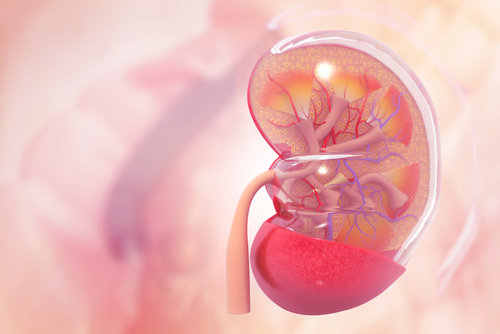Heat Shock Proteins in Kidneys Linked to Poorer Outcomes in AAV Patients
Written by |

A group of proteins that modulate immune responses, called heat shock proteins (HSPs), are significantly elevated in the kidneys of people with ANCA-associated vasculitis (AAV), and their levels are associated with poorer kidney function and organ survival, a multi-year study found.
These findings suggest that the heat shock protein system may affect patient outcomes in AAV.
The study, “Intense immunostaining of heat shock protein 70 within renal interstitium associates with long-term renal survival in an ANCA-associated vasculitis cohort,” was published in the journal Cell Stress and Chaperones.
AAV is an autoimmune disease in which antibodies generated by the immune system mistakenly attack white blood cells called neutrophils. This triggers the neutrophils to target and damage small blood vessels.
When this occurs in the tiny blood vessels (capillaries) within the functional units of the kidneys called nephrons, it can impede kidney function, potentially causing kidney (renal) failure.
Heat shock proteins (HSPs) help to maintain the integrity of other proteins during cellular stress. While HSPs typically work within the cell, some are secreted outside cells to modulate the immune response in various autoimmune diseases, including AAV.
Given the connection between HSPs and AAV, researchers at Saarland University Medical Center in Germany, along with investigators at Heraklion University Hospital in Greece, examined the relationship between two HSPs — HSP60 and HSP70 — and kidney health and survival in a group of AAV patients over a 20-year period.
The study enrolled 29 people with AAV, including 18 women, with a mean age of 58.
At the time of diagnosis, all patients were treated with the anti-inflammatory methylprednisolone at a high dose, which was then tapered to a lower dose that continued for two to five years. All also received cyclophosphamide, followed by azathioprine as a maintenance treatment.
Each patient was evaluated monthly for the first six months after treatment initiation, followed by annual visits, including assessments for disease-associated symptoms and blood tests.
Kidney tissue was isolated from the patients by biopsy and examined for damage and the presence of inflammatory cells. As biopsies could not be performed on healthy people for a comparison, kidney tissue from people who had their kidneys removed for reasons other than kidney disease served as controls.
All of the control kidney biopsies showed little or no production (expression) of HSP60 or HSP70. In contrast, HSP60 and HSP70 production within the various compartments of the kidney nephron was significantly higher in AAV patients compared with the control group.
Each kidney nephron consists of blood capillaries and a network of ducts called tubules. Here, blood is filtered to produce a fluid (filtrate), which flows into a tube called the glomerular (Bowman’s) capsule, and is then passed through additional secretion tubules to the bladder. The expansion of cells surrounding the glomerular capsule, called crescents, is a sign of inflammation and kidney damage.
HSP70 was found in most patients in the glomerular crescents, the tubules, and the damaged areas surrounding the nephron known as the interstitial space. HSP70 was also found in immune cells in the interstitial space. HSP60 was found in the tubules as well as in local immune cells.
Increased HSP70 production within the renal interstitium was associated with poorer renal function at the time of diagnosis, whereas HSP60 production within tubules was associated with increased interstitial inflammation.
Interstitial production of HSP70 was also associated with increased fibrosis — scarring due to the kidney’s limited ability to regenerate after injury — while the presence of this protein in the tubules was associated with fewer fibrosis.
Researchers then found that extensive fibrosis, involving more than 50% of the kidney, was associated with rapid loss of kidney function. In patients with less severe fibrosis, high levels of interstitial HSP70 at diagnosis linked with poorer renal survival.
“The observation that interstitial HSP70 overexpression is associated with worse renal outcomes, could imply that heat shock protein system has a role in the prognosis of ANCA-associated vasculitis,” the researchers concluded. “To our knowledge, this is the first study that shows an association of renal heat shock protein expression and renal outcomes in an ANCA vasculitis cohort.”
Further studies, they added, are needed to validate and “verify a causative association between HSP70 expression and renal outcomes in ANCA-associated vasculitis.”





